The Impact of Technological Dynamics and Fiscal Decentralization on Forest Resource Efficiency in China: The Mediating Role of Digital Economy
Abstract
:1. Introduction
2. Discussion of Former Literature
2.1. Technology and Forest Resources Efficiency
2.2. Fiscal Decentralization and Forest Resource Efficiency
2.3. Digital Economy and Forest Resource Efficiency
2.4. Research Gap
3. Variable, Data, and Methodology
3.1. Data and Variables
3.2. Variables Description
3.2.1. Dependent Variable (Forest Resource Efficiency (FRE))
3.2.2. Major Independent Variables
3.2.3. Control Variables
3.2.4. Moderation Variables
3.3. Empirical Modelling
4. Empirical Methods
4.1. Super SBM Data Envelopment Analysis for Forest Resource Efficiency
4.2. Econometric Methodology Path
4.3. Driscoll and Kraay (1998)
5. Discussion of the Findings
5.1. Forest Resource Efficiency Findings
5.2. Primary Econometric Findings
5.3. Long-Run Findings
5.3.1. Fiscal Decentralization, Technology Findings
5.3.2. Digital Economy’s Moderation Impact Findings
6. Conclusions
Limitations and Future Research
Author Contributions
Funding
Data Availability Statement
Conflicts of Interest
Appendix A
| Anhui | Heilongjiang | Qinghai | Zhejiang |
| Beijing | Henan | Shaanxi | |
| Chongqing | Hubei | Shandong | |
| Fujian | Hunan | Shanghai | |
| Gansu | Inner Mongolia | Shanxi | |
| Guangdong | Jiangsu | Sichuan | |
| Guangxi | Jiangxi | Tianjin | |
| Guizhou | Jilin | Tibet | |
| Hainan | Liaoning | Xinjiang | |
| Hebei | Ningxia | Yunnan |
References
- Tsai, W.T. Forest resource management and its climate-change mitigation policies in Taiwan. Climate 2020, 9, 3. [Google Scholar] [CrossRef]
- Harbi, J.; Erbaugh, J.T.; Sidiq, M.; Haasler, B.; Nurrochmat, D.R. Making a bridge between livelihoods and forest conservation: Lessons from non timber forest products’ utilization in South Sumatera, Indonesia. For. Policy Econ. 2018, 94, 1–10. [Google Scholar] [CrossRef]
- Dodev, Y.; Zhiyanski, M.; Glushkova, M.; Shin, W.S. Forest welfare services-the missing link between forest policy and management in the EU. For. Policy Econ. 2020, 118, 102249. [Google Scholar] [CrossRef]
- O’Brien, L.E.; Urbanek, R.E.; Gregory, J.D. Ecological functions and human benefits of urban forests. Urban For. Urban Green. 2022, 75, 127707. [Google Scholar] [CrossRef]
- Wani, A.M.; Sahoo, G. Forest ecosystem services and biodiversity. In Spatial Modeling in Forest Resources Management: Rural Livelihood and Sustainable Development; Springer: Berlin/Heidelberg, Germany, 2021; pp. 529–552. [Google Scholar]
- Watson, J.E.; Evans, T.; Venter, O.; Williams, B.; Tulloch, A.; Stewart, C.; Thompson, I.; Ray, J.C.; Murray, K.; Salazar, A.; et al. The exceptional value of intact forest ecosystems. Nat. Ecol. Evol. 2018, 2, 599–610. [Google Scholar] [CrossRef] [PubMed]
- Husen, A.; Bachheti, R.K.; Bachheti, A. (Eds.) Non-Timber Forest Products: Food, Healthcare and Industrial Applications; Springer International Publishing: Berlin/Heidelberg, Germany, 2021. [Google Scholar]
- He, Z.; Turner, P. A Systematic Review on Technologies and Industry 4.0 in the Forest Supply Chain: A Framework Identifying Challenges and Opportunities. Logistics 2021, 5, 88. [Google Scholar] [CrossRef]
- Kartal, M.T.; Pata, U.K.; Depren, Ö.; Erdogan, S. Effectiveness of nuclear and renewable electricity generation on CO2 emissions: Daily-based analysis for the major nuclear power generating countries. J. Clean. Prod. 2023, 426, 139121. [Google Scholar] [CrossRef]
- Bristol-Alagbariya, E.T. UN Convention to Combat Desertification as an International Environmental Regulatory Framework for Protecting and Restoring the World’s Land towards a Safer, More Just and Sustainable Future. Int. J. Energy Environ. Res. 2023, 11, 1–32. [Google Scholar]
- Adebayo, T.S.; Ullah, S.; Kartal, M.T.; Ali, K.; Pata, U.K.; Ağa, M. Endorsing sustainable development in BRICS: The role of technological innovation, renewable energy consumption, and natural resources in limiting carbon emission. Sci. Total Environ. 2023, 859, 160181. [Google Scholar] [CrossRef]
- Firoiu, D.; Ionescu, G.H.; Pîrvu, R.; Bădîrcea, R.; Patrichi, I.C. Achievement of the Sustainable Development Goals (Sdg) in Portugal and Forecast of Key Indicators until 2030. 2022. Available online: https://china.cdp.net/ (accessed on 6 November 2023).
- World Bank. Review on Sustainable Forest Management and Financing in China. Report No: AUS0001069. 2019. Available online: https://documents1.worldbank.org/curated/en/794721572413296261/pdf/Review-on-Sustainable-Forest-Management-and-Financing-in-China.pdf (accessed on 6 November 2023).
- Shi, M.; Qi, J.; Yin, R. Has China’s natural forest protection program protected forests?—Heilongjiang’s experience. Forests 2016, 7, 218. [Google Scholar] [CrossRef]
- Wu, L.T. Chinese Deforestation and Lessons from Its Conservation Efforts. 2022. Available online: https://earth.org/chinese-deforestation-and-lessons-from-its-conservation-efforts/ (accessed on 6 November 2023).
- Ke, S.; Qiao, D.; Zhang, X.; Feng, Q. Changes of China’s forestry and forest products industry over the past 40 years and challenges lying ahead. For. Policy Econ. 2021, 123, 102352. [Google Scholar] [CrossRef]
- Liu, Z.; Wang, W.J.; Ballantyne, A.; He, H.S.; Wang, X.; Liu, S.; Zhu, J. Forest disturbance decreased in China from 1986 to 2020 despite regional variations. Commun. Earth Environ. 2023, 4, 15. [Google Scholar] [CrossRef]
- Ahmad, N.; Youjin, L.; Žiković, S.; Belyaeva, Z. The effects of technological innovation on sustainable development and environmental degradation: Evidence from China. Technol. Soc. 2023, 72, 102184. [Google Scholar] [CrossRef]
- Li, L.; Hao, T.; Chi, T. Evaluation on China’s forestry resources efficiency based on big data. J. Clean. Prod. 2017, 142, 513–523. [Google Scholar] [CrossRef]
- Cheng, S.; Xu, Z.; Su, Y.; Zhen, L. Spatial and temporal flows of China’s forest resources: Development of a framework for evaluating resource efficiency. Ecol. Econ. 2010, 69, 1405–1415. [Google Scholar] [CrossRef]
- Gavilanes Montoya, A.V.; Castillo Vizuete, D.D.; Marcu, M.V. Exploring the Role of ICTs and Communication Flows in the Forest Sector. Sustainability 2023, 15, 10973. [Google Scholar] [CrossRef]
- Mushkarova, O.; Mikheeva, M.; Tereshchenko, S.; Panyutin, A.; Kuznetsov, E. Increasing the efficiency of the use of forest resources by the digitalization of forest education. In IOP Conference Series: Earth and Environmental Science; IOP Publishing: Bristol, UK, 2020; Volume 574, No. 1, p. 012054. [Google Scholar]
- Zhao, X.; Feng, Z.; Zhou, Y.; Lin, Y. Key Technologies of forest resource examination system development in China. Engineering 2020, 6, 491–494. [Google Scholar] [CrossRef]
- Ubina, N.A.; Lan, H.Y.; Cheng, S.C.; Chang, C.C.; Lin, S.S.; Zhang, K.X.; Hsieh, Y.Z. Digital twin-based intelligent fish farming with Artificial Intelligence Internet of Things (AIoT). Smart Agric. Technol. 2023, 5, 100285. [Google Scholar] [CrossRef]
- Peng, Y.; Huang, W. Using Blockchain Technology and Sharing Culture to Promote Sustainable Forest Management in Tribal Communities. J. Environ. Public Health 2022, 2022, 1529407. [Google Scholar] [CrossRef]
- Tebkew, M.; Atinkut, H.B. Impact of forest decentralization on sustainable forest management and livelihoods in East Africa. Trees For. People 2022, 10, 100346. [Google Scholar] [CrossRef]
- Nurfatriani, F.; Darusman, D.; Nurrochmat, D.R.; Yustika, A.E.; Muttaqin, M.Z. Redesigning Indonesian forest fiscal policy to support forest conservation. For. Policy Econ. 2015, 61, 39–50. [Google Scholar] [CrossRef]
- Hu, B.; Guo, M.; Zhang, S. The role of fiscal decentralization and natural resources markets in environmental sustainability in OECD. Resour. Policy 2023, 85, 103855. [Google Scholar] [CrossRef]
- Wright, G.D.; Andersson, K.P.; Gibson, C.C.; Evans, T.P. Decentralization can help reduce deforestation when user groups engage with local government. Proc. Natl. Acad. Sci. USA 2016, 113, 14958–14963. [Google Scholar] [CrossRef] [PubMed]
- García, C.; Espelta, J.M.; Hampe, A. Managing forest regeneration and expansion at a time of unprecedented global change. J. Appl. Ecol. 2020, 57, 2310–2315. [Google Scholar] [CrossRef]
- Wei, J.; Shen, M. Analysis of the efficiency of forest carbon sinks and its influencing factors—Evidence from China. Sustainability 2022, 14, 11155. [Google Scholar] [CrossRef]
- Zhang, Z.; Zhang, C. Revisiting the importance of forest rents, oil rents, green growth in economic performance of China: Employing time series methods. Resour. Policy 2023, 80, 103140. [Google Scholar] [CrossRef]
- Khan, Z.; Hussain, M.; Shahbaz, M.; Yang, S.; Jiao, Z. Natural resource abundance, technological innovation, and human capital nexus with financial development: A case study of China. Resour. Policy 2020, 65, 101585. [Google Scholar] [CrossRef]
- Zhang, X.; Ke, S. Linkage analysis of the resources, population, and economy in China’s key state-owned forest areas. Sustainability 2020, 12, 3855. [Google Scholar] [CrossRef]
- Yilanci, V.; Ulucak, R.; Zhang, Y.; Andreoni, V. The role of affluence, urbanization, and human capital for sustainable forest management in China: Robust findings from a new method of Fourier cointegration. Sustain. Dev. 2023, 31, 812–824. [Google Scholar] [CrossRef]
- Zhang, M.; Hafeez, M.; Faisal, C.M.N.; Iqbal, M.S. Natural resources, fiscal decentralization, and environmental quality in China: An empirical analysis from QARDL approach. In Environmental Science and Pollution Research; Springer: Berlin/Heidelberg, Germany, 2023; pp. 1–14. [Google Scholar]
- Xu, T.; Zhang, X.; Agrawal, A.; Liu, J. Decentralizing while centralizing: An explanation of China’s collective forestry reform since the 1980s. For. Policy Econ. 2020, 119, 102268. [Google Scholar] [CrossRef]
- Oldekop, J.A.; Sims, K.R.; Karna, B.K.; Whittingham, M.J.; Agrawal, A. Reductions in deforestation and poverty from decentralized forest management in Nepal. Nat. Sustain. 2019, 2, 421–428. [Google Scholar] [CrossRef]
- Chen, C.; Ye, F.; Xiao, H.; Xie, W.; Liu, B.; Wang, L. The digital economy, spatial spillovers and forestry green total factor productivity. J. Clean. Prod. 2023, 405, 136890. [Google Scholar] [CrossRef]
- Chen, H.; Ma, Z.; Xiao, H.; Li, J.; Chen, W. The Impact of Digital Economy Empowerment on Green Total Factor Productivity in Forestry. Forests 2023, 14, 1729. [Google Scholar] [CrossRef]
- Watanabe, C.; Naveed, N.; Neittaanmäki, P. Digital solutions transform the forest-based bioeconomy into a digital platform industry-A suggestion for a disruptive business model in the digital economy. Technol. Soc. 2018, 54, 168–188. [Google Scholar] [CrossRef]
- Nitoslawski, S.A.; Wong-Stevens, K.; Steenberg JW, N.; Witherspoon, K.; Nesbitt, L.; Konijnendijk van den Bosch, C.C. The digital forest: Mapping a decade of knowledge on technological applications for forest ecosystems. Earth’s Future 2021, 9, e2021EF002123. [Google Scholar] [CrossRef]
- Singh, R.; Gehlot, A.; Akram, S.V.; Thakur, A.K.; Buddhi, D.; Das, P.K. Forest 4.0: Digitalization of forest using the Internet of Things (IoT). J. King Saud Univ. Comput. Inf. Sci. 2022, 34, 5587–5601. [Google Scholar] [CrossRef]
- Morkovina, S.; Nasriddinov, S.; Shanin, I. Forestry digital platform of Russia. In IOP Conference Series: Earth and Environmental Science; IOP Publishing: Bristol, UK, 2020; Volume 595, No. 1, p. 012042. [Google Scholar]
- Shivaprakash, K.N.; Swami, N.; Mysorekar, S.; Arora, R.; Gangadharan, A.; Vohra, K.; Jadeyegowda, M.; Kiesecker, J.M. Potential for artificial intelligence (AI) and machine learning (ML) applications in biodiversity conservation, managing forests, and related services in India. Sustainability 2022, 14, 7154. [Google Scholar] [CrossRef]
- Hoover, C.; Stout, S. The carbon consequences of thinning techniques: Stand structure makes a difference. J. For. 2007, 105, 266–270. [Google Scholar]
- Lu, C.C.; Lin, I.F.; Wu, D.; Zhang, X. The effect of forestry on energy efficiency in EU countries: A non-oriented dynamic slack-based data envelopment analysis. Energy Sci. Eng. 2021, 9, 1148–1159. [Google Scholar] [CrossRef]
- Huang, X.J.; An, R.; Yu, M.M.; He, F.F. Tourism efficiency decomposition and assessment of forest parks in China using dynamic network data envelopment analysis. J. Clean. Prod. 2022, 363, 132405. [Google Scholar] [CrossRef]
- Mohammadi Limaei, S. Efficiency analysis of forest management units considering economics and carbon dynamic: A data envelopment analysis (DEA) approach. Austrian J. For. Sci. 2020, 137, 199–222. [Google Scholar]
- Akay, A.O. Wood harvesting efficiency analysis of regional forest directorates in Turkey: K-means clustering and data envelopment analysis approach. Int. J. For. Eng. 2023, 34, 176–189. [Google Scholar] [CrossRef]
- Xiang, J.; Xing, Y.; Wei, W.; Yan, E.; Jiang, J.; Mo, D. Dynamic Detection of Forest Change in Hunan Province Based on Sentinel-2 Images and Deep Learning. Remote Sens. 2023, 15, 628. [Google Scholar] [CrossRef]
- Spinelli, R.; Magagnotti, N. The effects of introducing modern technology on the financial, labour and energy performance of forest operations in the Italian Alps. For. Policy Econ. 2011, 13, 520–524. [Google Scholar] [CrossRef]
- Lu, Y.N.; Yao, S.; Ding, Z.; Deng, Y.; Hou, M. Did government expenditure on the grain for green project help the forest carbon sequestration increase in Yunnan, China? Land 2020, 9, 54. [Google Scholar] [CrossRef]
- Ullah, S.; Khan, M.; Yoon, S.M. Measuring energy poverty and its impact on economic growth in Pakistan. Sustainability 2021, 13, 10969. [Google Scholar] [CrossRef]
- de Castro Dias, T.C.A.; da Cunha, A.C.; da Silva, J.M.C. Return on investment of the ecological infrastructure in a new forest frontier in Brazilian Amazonia. Biol. Conserv. 2016, 194, 184–193. [Google Scholar] [CrossRef]
- Nef, D.P.; Gotor, E.; Wiederkehr Guerra, G.; Zumwald, M.; Kettle, C.J. Initial investment in diversity is the efficient thing to do for resilient forest landscape restoration. Front. For. Glob. Chang. 2021, 3, 615682. [Google Scholar] [CrossRef]
- Tone, K.A. Slacks-Based Measure of Super-Efficiency in Data Envelopment Analysis. Eur. J. Oper. Res. 2002, 143, 32–41. [Google Scholar] [CrossRef]
- Yasmeen, R.; Tao, R.; Shah, W.U.H. Economic growth and environmental technology simultaneously important for reducing energy poverty and ecological footprint in E7 economies: Do political institutions play a role? Environ. Sci. Pollut. Res. 2023, 30, 65102–65118. [Google Scholar] [CrossRef]
- Pesaran, M.H. General diagnostic tests for cross section dependence in panels. Empir. Econ. 2021, 60, 13–50. [Google Scholar] [CrossRef]
- Pesaran, M.H. Testing weak cross-sectional dependence in large panels. Econom. Rev. 2015, 34, 1089–1117. [Google Scholar] [CrossRef]
- Pesaran, M.H.; Yamagata, T. Testing slope homogeneity in large panels. J. Econom. 2008, 142, 50–93. [Google Scholar] [CrossRef]
- Pesaran, M.H. A simple panel unit root test in the presence of cross-section dependence. J. Appl. Econom. 2007, 22, 265–312. [Google Scholar] [CrossRef]
- Westerlund, J. New simple tests for panel cointegration. Econom. Rev. 2005, 24, 297–316. [Google Scholar] [CrossRef]
- Driscoll, J.C.; Kraay, A.C. Consistent covariance matrix estimation with spatially dependent panel data. Rev. Econ. Stat. 1998, 80, 549–560. [Google Scholar] [CrossRef]
- Baloch, M.A.; Khan, S.U.D.; Ulucak, Z.Ş.; Ahmad, A. Analyzing the relationship between poverty, income inequality, and CO2 emission in Sub-Saharan African countries. Sci. Total Environ. 2020, 740, 139867. [Google Scholar] [CrossRef]
- Baloch, M.A.; Zhang, J.; Iqbal, K.; Iqbal, Z. The effect of financial development on ecological footprint in BRI countries: Evidence from panel data estimation. Environ. Sci. Pollut. Res. 2019, 26, 6199–6208. [Google Scholar] [CrossRef]
- Yasmeen, R.; Yao, X.; Padda IU, H.; Shah WU, H.; Jie, W. Exploring the role of solar energy and foreign direct investment for clean environment: Evidence from top 10 solar energy consuming countries. Renew. Energy 2022, 185, 147–158. [Google Scholar] [CrossRef]
- Chandio, A.A.; Sethi, N.; Dash, D.P.; Usman, M. Towards sustainable food production: What role ICT and technological development can play for cereal production in Asian–7 countries? Comput. Electron. Agric. 2022, 202, 107368. [Google Scholar] [CrossRef]
- Hao, Y.; Xu, Y.; Zhang, J.; Hu, X.; Huang, J.; Chang, C.P.; Guo, Y. Relationship between forest resources and economic growth: Empirical evidence from China. J. Clean. Prod. 2019, 214, 848–859. [Google Scholar] [CrossRef]
- Prochazka, P.; Abrham, J.; Cerveny, J.; Kobera, L.; Sanova, P.; Benes, D.; Smutka, L. Understanding the socio-economic causes of deforestation: A global perspective. Front. For. Glob. Chang. 2023, 6, 1288365. [Google Scholar] [CrossRef]
- Chang, C.W. Relationship between GDP Growth and Deforestation in the Central American and Caribbean Countries with Further Analysis on the Major GDP Earning Industries among These Countries and Their Contribution to Deforestation. Ph.D. Thesis, KDI School, Sejong-si, Republic of Korea, 2017. [Google Scholar]
- Guerrero, J.E. Evaluation of Cross-Sector Collaborations in Transition toward the Bioeconomy: Benefits, Challenges, and Opportunities in the Forest Sector. 2019. Available online: https://ir.library.oregonstate.edu/concern/graduate_thesis_or_dissertations/6969z681z (accessed on 6 November 2023).
- Simbi, N.; Panagiota, K. Managing Open Digital Technology in the Cluster Environment: A Case Study of the Cluster of Forest Technology. 2019. Available online: https://www.semanticscholar.org/paper/Managing-Open-Digital-Innovation-in-a-Cluster-A-of-Simbi-Koukouvinou/244fe21e79e2c0069eeedf304a70b228f06ba8c9 (accessed on 6 November 2023).
- Chen, N.; Qin, F.; Zhai, Y.; Cao, H.; Zhang, R.; Cao, F. Evaluation of coordinated development of forestry management efficiency and forest ecological security: A spatiotemporal empirical study based on China’s provinces. J. Clean. Prod. 2020, 260, 121042. [Google Scholar] [CrossRef]
- Batala, L.K.; Qiao, J.; Regmi, K.; Weiwen, W.; Rehman, A. The implications of forest resources depletion, agricultural expansion, and financial development on energy demand and ecological footprint in BRI countries. Clean Technol. Environ. Policy 2023, 25, 2845–2861. [Google Scholar] [CrossRef]
- Rodríguez-Espíndola, O.; Cuevas-Romo, A.; Chowdhury, S.; Díaz-Acevedo, N.; Albores, P.; Despoudi, S.; Dey, P. The role of circular economy principles and sustainable-oriented innovation to enhance social, economic and environmental performance: Evidence from Mexican SMEs. Int. J. Prod. Econ. 2022, 248, 108495. [Google Scholar] [CrossRef]
- Delphin, S.; Escobedo, F.J.; Abd-Elrahman, A.; Cropper, W.P. Urbanization as a land use change driver of forest ecosystem services. Land Use Policy 2016, 54, 188–199. [Google Scholar] [CrossRef]
- Liu, W.; Zhan, J.; Zhao, F.; Yan, H.; Zhang, F.; Wei, X. Impacts of urbanization-induced land-use changes on ecosystem services: A case study of the Pearl River Delta Metropolitan Region, China. Ecol. Indic. 2019, 98, 228–238. [Google Scholar] [CrossRef]
- Vermesan, O.; Friess, P. (Eds.) Digitising the Industry Internet of Things Connecting the Physical, Digital and VirtualWorlds; CRC Press: Boca Raton, FL, USA, 2022. [Google Scholar]
- Bachmann, N.; Tripathi, S.; Brunner, M.; Jodlbauer, H. The contribution of data-driven technologies in achieving the sustainable development goals. Sustainability 2022, 14, 2497. [Google Scholar] [CrossRef]
- Heilig, L.; Stahlbock, R.; Voß, S. From digitalization to data-driven decision making in container terminals. In Handbook of Terminal Planning; Springer: Berlin/Heidelberg, Germany, 2020; pp. 125–154. [Google Scholar]
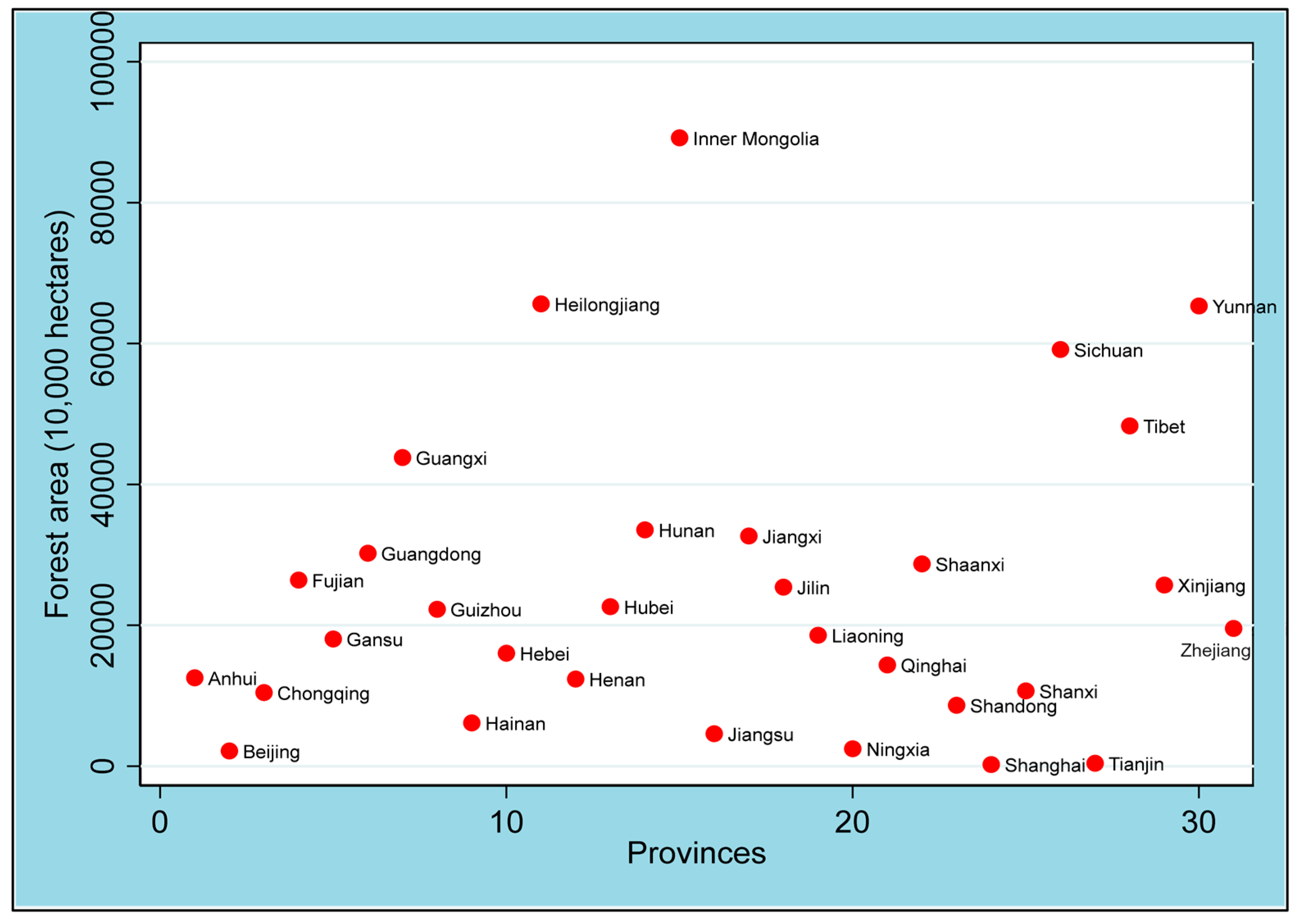


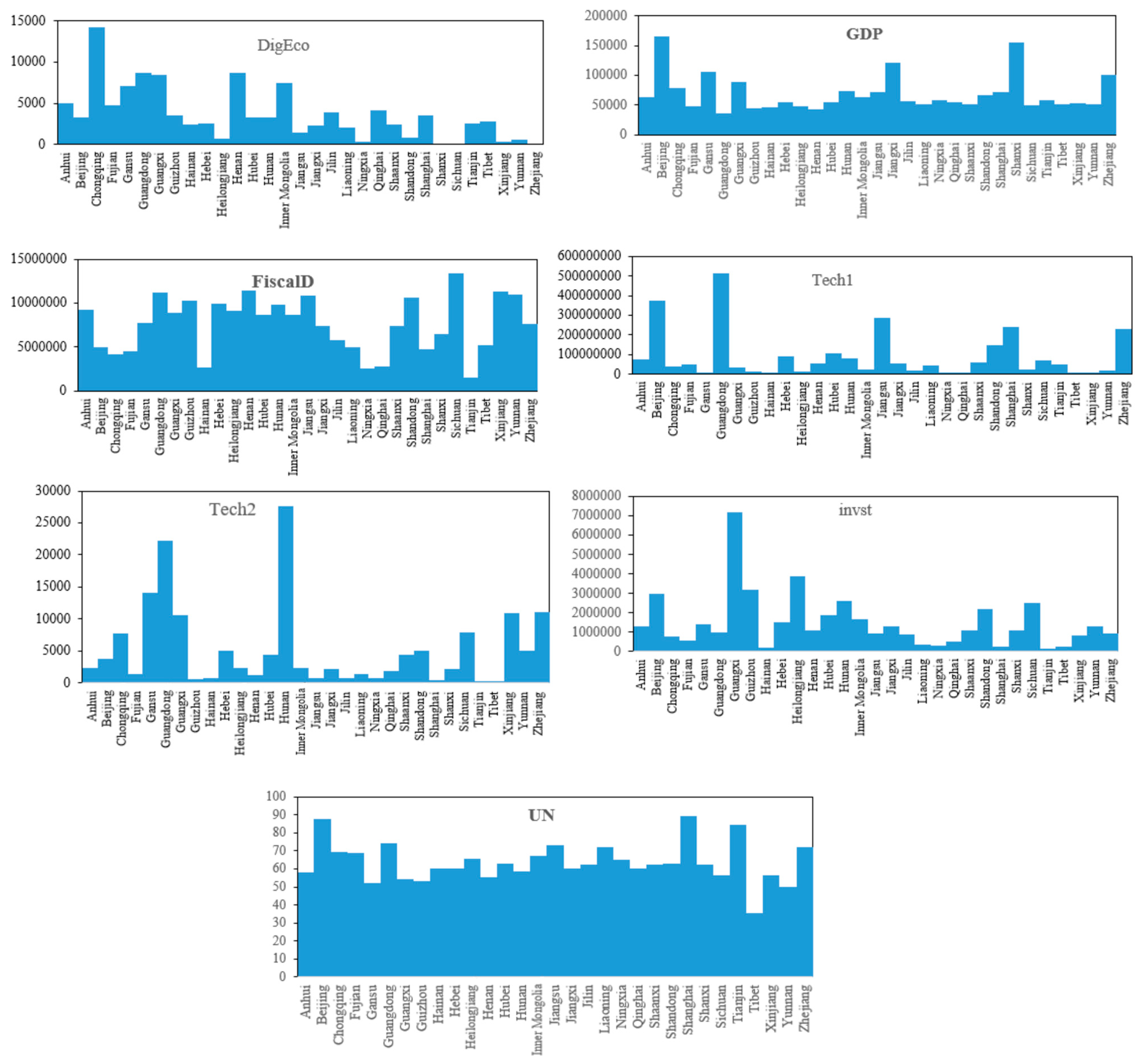



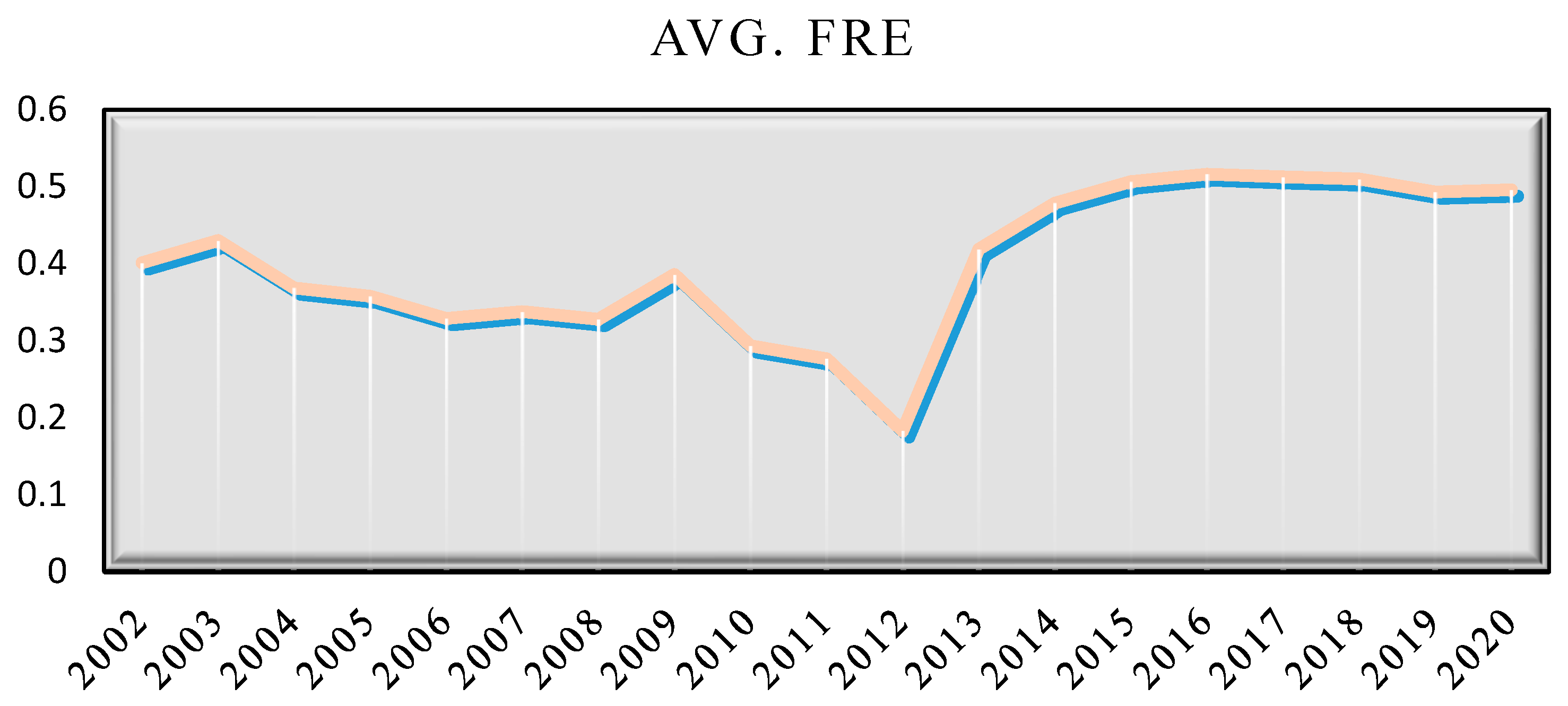
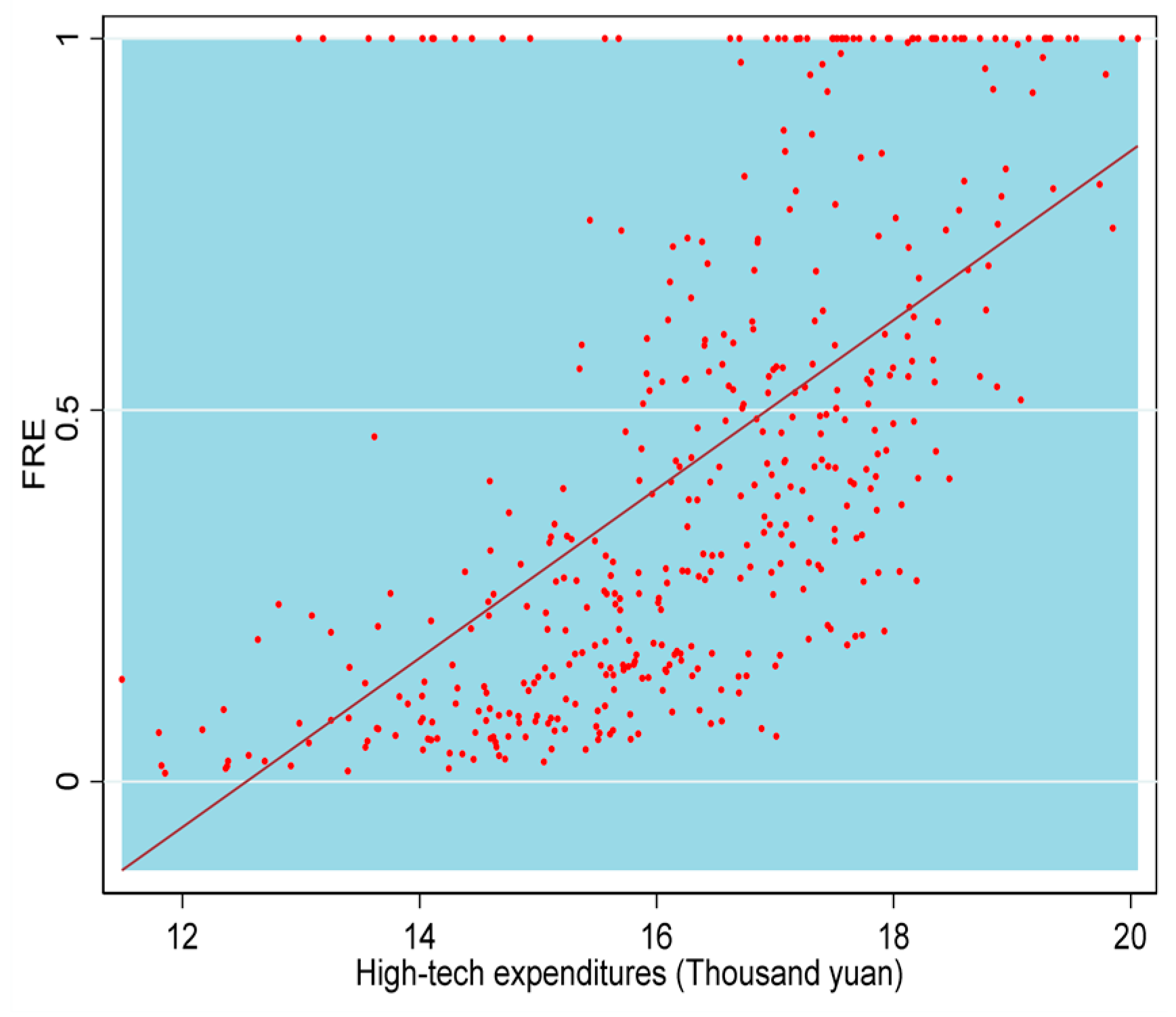
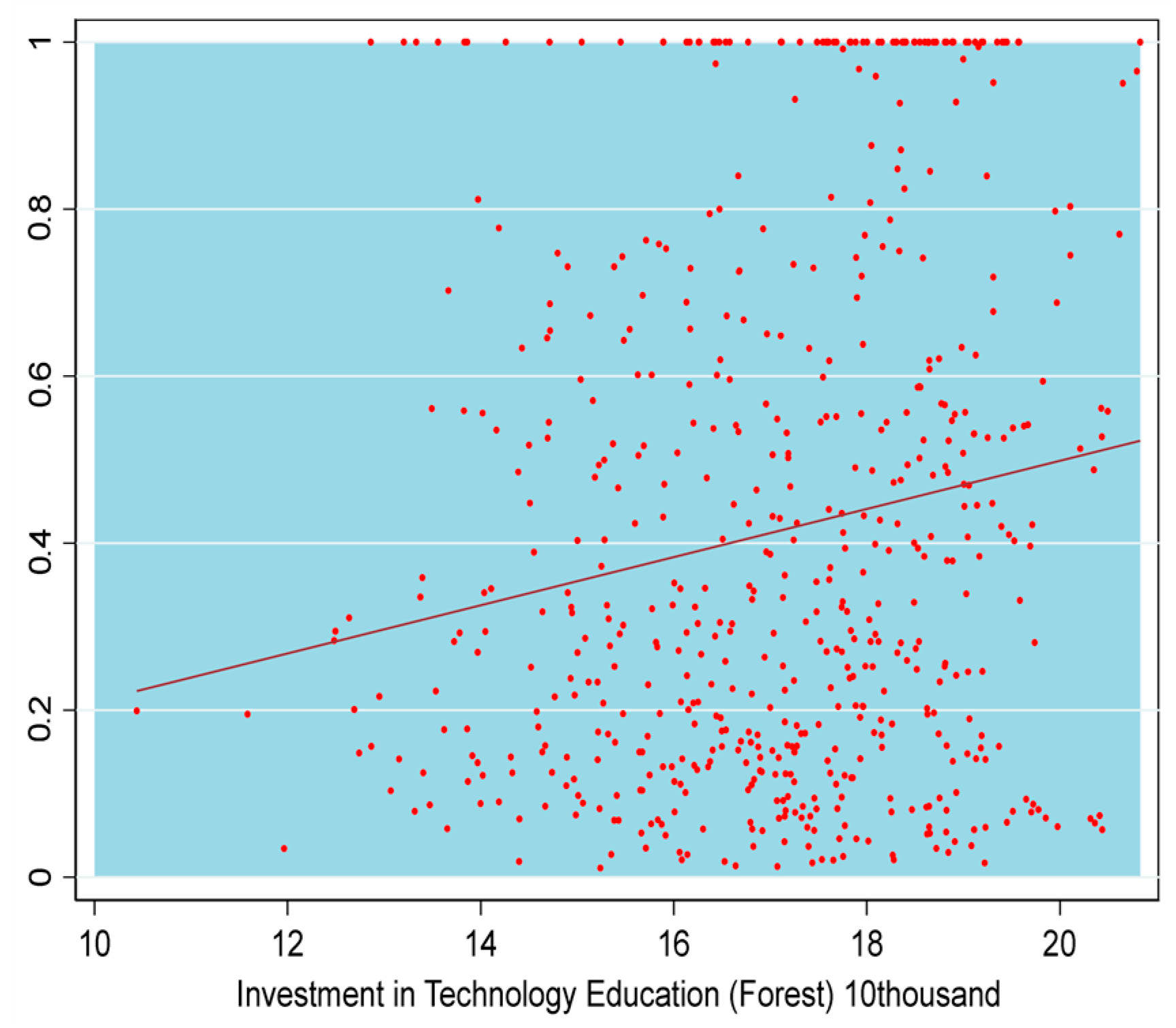

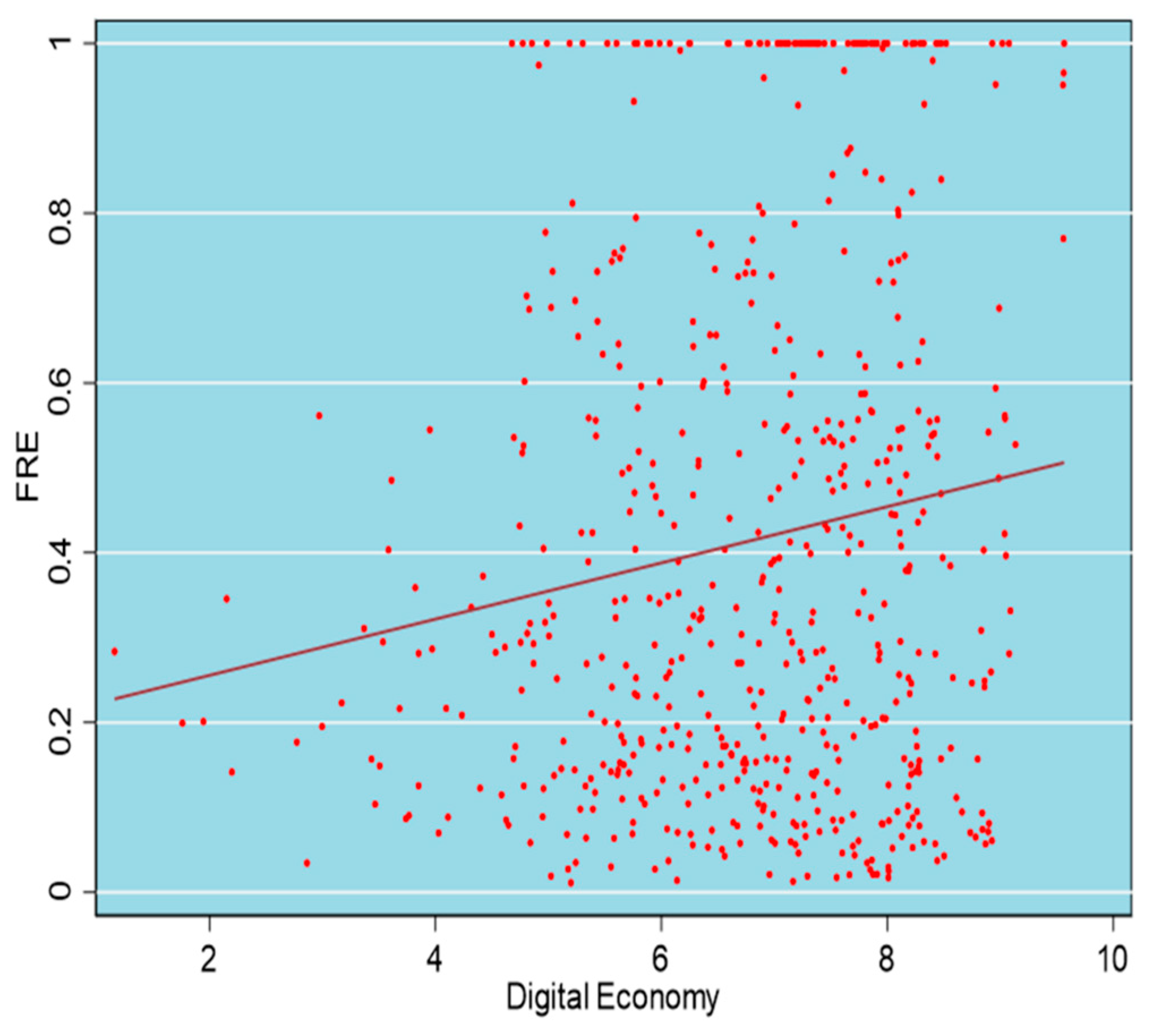
| Variable | Measurement | Mean | Std. | Min | Max |
|---|---|---|---|---|---|
| FRE | Inputs: (i) Forest area (10,000 hectares), (ii) Investment (10 thousand Yuan), (iii) Employees (10 thousand persons). Output: Forestry output value (100 million yuan). | 0.4140311 | 0.3130816 | 0.0112 | 1 |
| GDP | GDP per Capita (yuan) | 38,037.18 | 27,576.64 | 3257 | 164,889.5 |
| Tech1 | High-tech expenditures on scientific research activities (Thousand yuan) | 3.61 × 107 | 6.38 × 107 | 97,634 | 5.15 × 108 |
| Tech2 | Investment in Technology Education (Forest) 10 thousand yuan | 2675.41 | 5301.768 | 1 | 57,360 |
| FiscalD | Local Government Expenditure on Forest (10 thousand yuan) | 4,331,433 | 2,875,321 | 229,619 | 1.34 × 107 |
| invst | Completed Investment in Forest (10 thousand yuan) | 807,442.2 | 1,285,912 | 3492 | 1.09 × 107 |
| UN | Urban Population% of total population | 52.23012 | 15.42139 | 20.85 | 90.26 |
| DigEco | Internet User (10,000 persons) | 1833.297 | 2143.533 | 3.19 | 14,251.39 |
| Moderation1 | 8.41 × 107 | 1.42 × 108 | 34,110.51 | 1.11 × 109 | |
| Moderation2 | 8.06 × 109 | 1.46 × 1010 | 4.59 × 109 | 1.00 × 1011 | |
| Moderation3 | 8.01 × 1010 | 3.13 × 1011 | 3.02 × 1010 | 4.51 × 1012 | |
| Moderation4 | 3,720,246 | 5.07 × 107 | 6.98 × 108 | 5.31 × 108 | |
| Moderation5 | 103,549.9 | 133,797.7 | 154.546 | 989,902.3 |
| Variable | CD-Test | p-Value | Average Joint T | Mean ρ | Mean abs (ρ) |
|---|---|---|---|---|---|
| FRE | 36.733 | 0.000 | 19.00 | 0.39 | 0.49 |
| GDP | 92.433 | 0.000 | 19.00 | 0.98 | 0.98 |
| DigEco | 28.512 | 0.000 | 19.00 | 0.3 | 0.44 |
| FiscalD | 92.153 | 0.000 | 19.00 | 0.98 | 0.98 |
| Tech1 | 71.276 | 0.000 | 19.00 | 0.76 | 0.76 |
| UN | 77.659 | 0.000 | 19.00 | 0.83 | 0.87 |
| Tech2 | 20.937 | 0.000 | 19.00 | 0.22 | 0.54 |
| invst | 81.676 | 0.000 | 19.00 | 0.87 | 0.87 |
| Moderation1 | 56.352 | 0.000 | 19.00 | 0.60 | 0.60 |
| Moderation2 | 60.351 | 0.000 | 19.00 | 0.71 | 0.71 |
| Moderation3 | 56.332 | 0.000 | 19.00 | 0.62 | 0.63 |
| Moderation5 | 47.284 | 0.000 | 19.00 | 0.53 | 0.62 |
| Moderation4 | 34.356 | 0.000 | 19.00 | 0.37 | 0.44 |
| Models | ∆ (Delta) | Pr | Adj (∆) | Pr |
|---|---|---|---|---|
| Base line-Model1 | 3.052 | 0.002 | 5.328 | 0.000 |
| Base line-Model2 | 2.219 | 0.026 | 4.605 | 0.000 |
| Variable(s) | CIPS—Level | CIPS—First Difference | ||
|---|---|---|---|---|
| Trend—Exclusive | Trend—Inclusive | Trend—Exclusive | Trend—Inclusive | |
| FRE | −2.415 ** | −3.352 *** | −4.686 *** | −4.644 *** |
| GDP | −1.455 | −2.705 | −3.555 *** | −3.836 *** |
| DigEco | −3.818 *** | −3.709 *** | −4.775 *** | −5.020 *** |
| FiscalD | −1.628 | −1.864 | −2.985 ** | −3.998 *** |
| Tech1 | −3.021 *** | −3.751 *** | −3.299 *** | −3.563 *** |
| UN | −2.040 | −1.940 | −3.144 *** | −3.566 *** |
| Tech2 | −1.200 | −1.777 | −3.392 *** | −3.973 *** |
| invst | −2.915 * | −3.192 *** | −4.738 *** | −4.876 *** |
| Moderation1 | −2.608 *** | −3.711 *** | −4.532 *** | −4.766 *** |
| Moderation2 | −2.662 *** | −3.317 *** | −4.007 *** | −4.260 *** |
| Moderation3 | −3.562 *** | −4.072 *** | −5.028 *** | −4.944 *** |
| Moderation4 | −0.698 | −1.271 | −2.825 * | −3.586 *** |
| Moderation5 | −3.441 *** | −3.862 *** | −4.598 *** | −4.803 *** |
| Models | Panels (Specification) | Statistic | p-Value |
|---|---|---|---|
| Baseline-Model1 | Some Panels | −3.3032 | 0.0005 |
| All Panels | −2.3656 | 0.0090 | |
| Baseline-Model2 | Some Panels | −1.3729 | 0.0849 |
| All Panels | −1.6671 | 0.0478 |
| Fiscal Decentralization, Technology Impact Model | ||||
|---|---|---|---|---|
| Variables | FRE | FRE | FRE | FRE |
| GDP | −0.0589 ** | −0.0484 ** | −0.0442 * | −0.0247 *** |
| (0.0255) | (0.0179) | (0.0245) | (0.00758) | |
| FiscalD | 0.113 *** | 0.0255 *** | 0.0367 * | 0.0400 |
| (0.0368) | (0.00824) | (0.0183) | (0.0305) | |
| Tech1 | 0.133 *** | 0.120 *** | 0.141 *** | |
| (0.0122) | (0.0147) | (0.0138) | ||
| UN | −0.0221 ** | −0.453 *** | −0.0804 ** | −0.124 *** |
| (0.00870) | (0.0534) | (0.0381) | (0.0396) | |
| Tech2 | 0.0385 *** | 0.0155 ** | 0.00361 ** | |
| (0.00971) | (0.00675) | (0.00131) | ||
| invst | 0.0993 *** | |||
| (0.0174) | ||||
| Constant | −43.86 ** | −45.71 *** | −52.90 *** | −49.10 *** |
| (16.86) | (8.574) | (16.91) | (14.89) | |
| Number of groups | 31 | 31 | 31 | 31 |
| Moderation of the Digital Economy Model | ||||||
|---|---|---|---|---|---|---|
| Variables | FRE | FRE | FRE | FRE | FRE | FRE |
| DigEco | 0.0218 *** | |||||
| (0.00397) | ||||||
| GDP | −0.141 * | −0.104 *** | −0.0807 *** | −0.0370 * | −0.0941 ** | −0.0396 ** |
| (0.0693) | (0.0171) | (0.00891) | (0.0181) | (0.0446) | (0.0169) | |
| FiscalD | 0.0531 ** | 0.348 *** | 0.0683 *** | 0.0241 *** | 0.114 *** | 0.668 *** |
| (0.0226) | (0.0980) | (0.0214) | (0.00791) | (0.0325) | (0.177) | |
| Tech1 | 0.133 *** | 0.141 *** | 0.108 *** | 0.111 *** | 0.130 *** | 0.0756 ** |
| (0.0132) | (0.0141) | (0.00978) | (0.0124) | (0.0103) | (0.0336) | |
| UN | −0.117 ** | −0.442 *** | −0.818 *** | −0.126 *** | −0.474 *** | −0.868 *** |
| (0.0416) | (0.0692) | (0.197) | (0.0396) | (0.0661) | (0.177) | |
| Tech2 | 0.00172 | 0.00526 | 0.00103 | 0.0162 | 0.000693 | 0.00258 |
| (0.00478) | (0.00505) | (0.00892) | (0.0250) | (0.00687) | (0.00260) | |
| invst | 0.0950 *** | 0.0896 *** | 0.0151 ** | 0.0461 *** | 0.0956 *** | 0.0693 *** |
| (0.0153) | (0.0199) | (0.00673) | (0.0143) | (0.0149) | (0.0190) | |
| Moderation1 | 0.0154 *** | |||||
| (0.00450) | ||||||
| Moderation2 | 0.0104 ** | |||||
| (0.00400) | ||||||
| Moderation3 | 0.0671 *** | |||||
| (0.0173) | ||||||
| Moderation4 | 0.0163 ** | |||||
| (0.00584) | ||||||
| Moderation5 | 0.0728 *** | |||||
| (0.00397) | ||||||
| Constant | −45.23 *** | −47.91 *** | −42.41 ** | −24.55 ** | −19.91 | −37.63 *** |
| (15.51) | (15.51) | (17.99) | (9.199) | (14.66) | (11.28) | |
| Number of groups | 31 | 31 | 31 | 31 | 31 | 31 |
Disclaimer/Publisher’s Note: The statements, opinions and data contained in all publications are solely those of the individual author(s) and contributor(s) and not of MDPI and/or the editor(s). MDPI and/or the editor(s) disclaim responsibility for any injury to people or property resulting from any ideas, methods, instructions or products referred to in the content. |
© 2023 by the authors. Licensee MDPI, Basel, Switzerland. This article is an open access article distributed under the terms and conditions of the Creative Commons Attribution (CC BY) license (https://creativecommons.org/licenses/by/4.0/).
Share and Cite
Yasmeen, R.; Hao, G.; Yan, H.; Shah, W.U.H. The Impact of Technological Dynamics and Fiscal Decentralization on Forest Resource Efficiency in China: The Mediating Role of Digital Economy. Forests 2023, 14, 2416. https://doi.org/10.3390/f14122416
Yasmeen R, Hao G, Yan H, Shah WUH. The Impact of Technological Dynamics and Fiscal Decentralization on Forest Resource Efficiency in China: The Mediating Role of Digital Economy. Forests. 2023; 14(12):2416. https://doi.org/10.3390/f14122416
Chicago/Turabian StyleYasmeen, Rizwana, Gang Hao, Hong Yan, and Wasi Ul Hassan Shah. 2023. "The Impact of Technological Dynamics and Fiscal Decentralization on Forest Resource Efficiency in China: The Mediating Role of Digital Economy" Forests 14, no. 12: 2416. https://doi.org/10.3390/f14122416
APA StyleYasmeen, R., Hao, G., Yan, H., & Shah, W. U. H. (2023). The Impact of Technological Dynamics and Fiscal Decentralization on Forest Resource Efficiency in China: The Mediating Role of Digital Economy. Forests, 14(12), 2416. https://doi.org/10.3390/f14122416





